1999 NISSAN PRIMERA sensor
[x] Cancel search: sensorPage 2178 of 2267
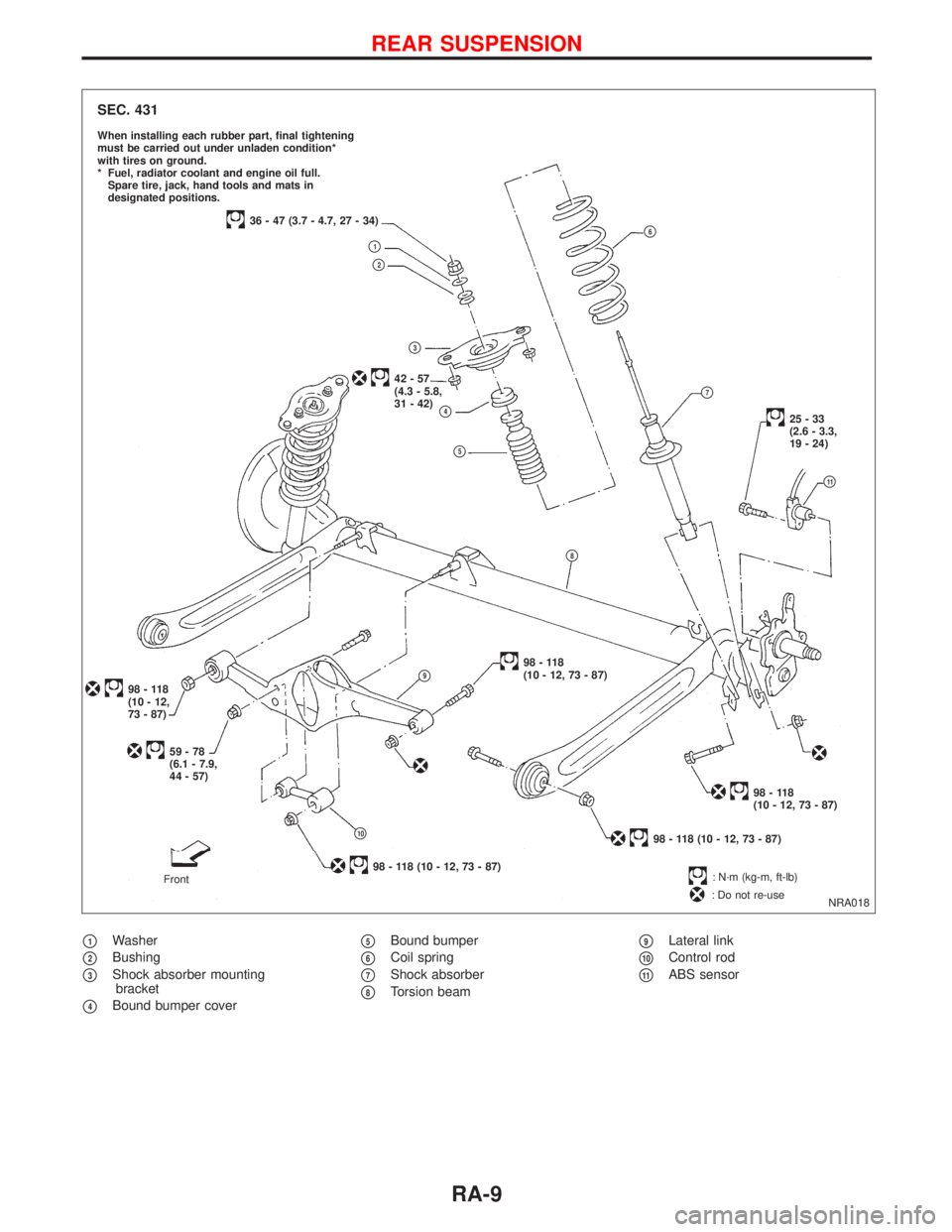
p1Washer
p2Bushing
p3Shock absorber mounting
bracket
p4Bound bumper cover
p5Bound bumper
p6Coil spring
p7Shock absorber
p8Torsion beam
p9Lateral link
p10Control rod
p11ABS sensor
NRA018
SEC. 431
When installing each rubber part, final tightening
must be carried out under unladen condition*
with tires on ground.
* Fuel, radiator coolant and engine oil full.
Spare tire, jack, hand tools and mats in
designated positions.
36 - 47 (3.7 - 4.7, 27 - 34)
p1
p2
p3
42-57
(4.3 - 5.8,
31 - 42)
p4
p5
p6
p7
25-33
(2.6 - 3.3,
19 - 24)
p8
98-118
(10 - 12, 73 - 87)p9
p10
98-118
(10 - 12,
73 - 87)
59-78
(6.1 - 7.9,
44 - 57)
Front
98 - 118 (10 - 12, 73 - 87)
p11
98-118
(10 - 12, 73 - 87)
: N´m (kg-m, ft-lb)
: Do not re-use
98 - 118 (10 - 12, 73 - 87)
REAR SUSPENSION
RA-9
Page 2179 of 2267
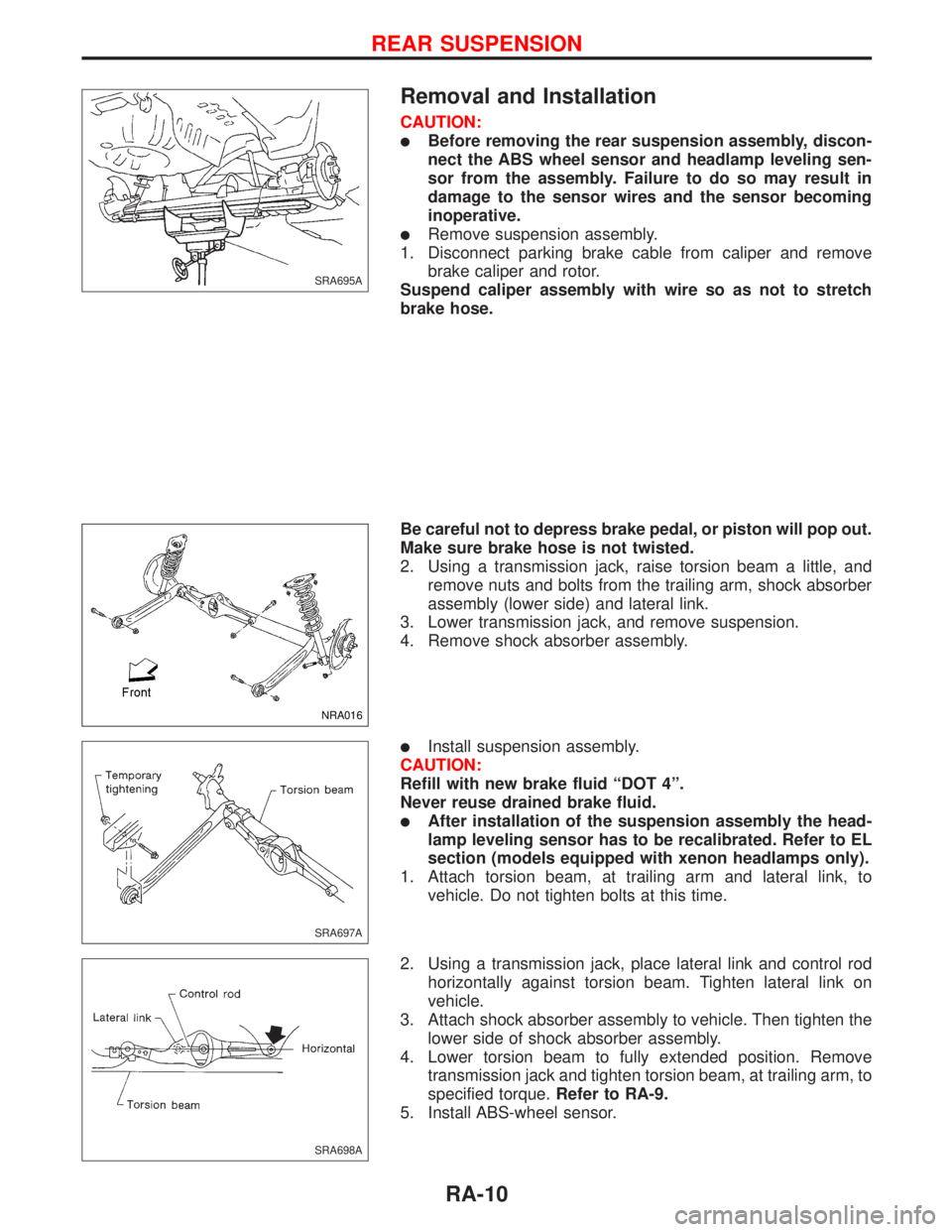
Removal and Installation
CAUTION:
lBefore removing the rear suspension assembly, discon-
nect the ABS wheel sensor and headlamp leveling sen-
sor from the assembly. Failure to do so may result in
damage to the sensor wires and the sensor becoming
inoperative.
lRemove suspension assembly.
1. Disconnect parking brake cable from caliper and remove
brake caliper and rotor.
Suspend caliper assembly with wire so as not to stretch
brake hose.
Be careful not to depress brake pedal, or piston will pop out.
Make sure brake hose is not twisted.
2. Using a transmission jack, raise torsion beam a little, and
remove nuts and bolts from the trailing arm, shock absorber
assembly (lower side) and lateral link.
3. Lower transmission jack, and remove suspension.
4. Remove shock absorber assembly.
lInstall suspension assembly.
CAUTION:
Refill with new brake fluid ªDOT 4º.
Never reuse drained brake fluid.
lAfter installation of the suspension assembly the head-
lamp leveling sensor has to be recalibrated. Refer to EL
section (models equipped with xenon headlamps only).
1. Attach torsion beam, at trailing arm and lateral link, to
vehicle. Do not tighten bolts at this time.
2. Using a transmission jack, place lateral link and control rod
horizontally against torsion beam. Tighten lateral link on
vehicle.
3. Attach shock absorber assembly to vehicle. Then tighten the
lower side of shock absorber assembly.
4. Lower torsion beam to fully extended position. Remove
transmission jack and tighten torsion beam, at trailing arm, to
specified torque.Refer to RA-9.
5. Install ABS-wheel sensor.
SRA695A
NRA016
SRA697A
SRA698A
REAR SUSPENSION
RA-10
Page 2184 of 2267
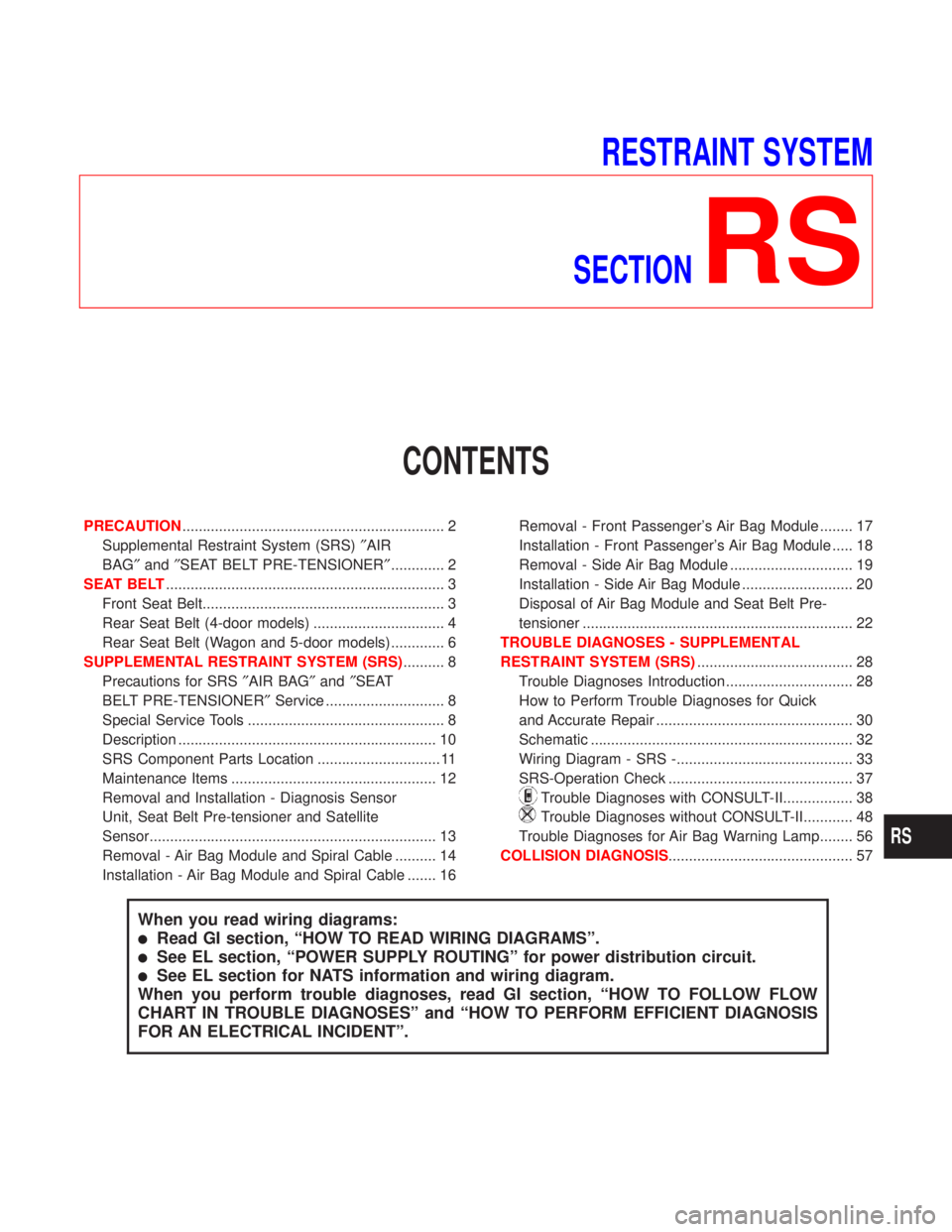
RESTRAINT SYSTEM
SECTION
RS
CONTENTS
PRECAUTION................................................................ 2
Supplemental Restraint System (SRS)²AIR
BAG²and²SEAT BELT PRE-TENSIONER²............. 2
SEAT BELT.................................................................... 3
Front Seat Belt........................................................... 3
Rear Seat Belt (4-door models) ................................ 4
Rear Seat Belt (Wagon and 5-door models)............. 6
SUPPLEMENTAL RESTRAINT SYSTEM (SRS).......... 8
Precautions for SRS²AIR BAG²and²SEAT
BELT PRE-TENSIONER²Service ............................. 8
Special Service Tools ................................................ 8
Description ............................................................... 10
SRS Component Parts Location .............................. 11
Maintenance Items .................................................. 12
Removal and Installation - Diagnosis Sensor
Unit, Seat Belt Pre-tensioner and Satellite
Sensor...................................................................... 13
Removal - Air Bag Module and Spiral Cable .......... 14
Installation - Air Bag Module and Spiral Cable ....... 16Removal - Front Passenger's Air Bag Module ........ 17
Installation - Front Passenger's Air Bag Module ..... 18
Removal - Side Air Bag Module .............................. 19
Installation - Side Air Bag Module ........................... 20
Disposal of Air Bag Module and Seat Belt Pre-
tensioner .................................................................. 22
TROUBLE DIAGNOSES - SUPPLEMENTAL
RESTRAINT SYSTEM (SRS)...................................... 28
Trouble Diagnoses Introduction............................... 28
How to Perform Trouble Diagnoses for Quick
and Accurate Repair ................................................ 30
Schematic ................................................................ 32
Wiring Diagram - SRS -........................................... 33
SRS-Operation Check ............................................. 37
Trouble Diagnoses with CONSULT-II................. 38
Trouble Diagnoses without CONSULT-II............ 48
Trouble Diagnoses for Air Bag Warning Lamp........ 56
COLLISION DIAGNOSIS............................................. 57
When you read wiring diagrams:
lRead GI section, ªHOW TO READ WIRING DIAGRAMSº.
lSee EL section, ªPOWER SUPPLY ROUTINGº for power distribution circuit.
lSee EL section for NATS information and wiring diagram.
When you perform trouble diagnoses, read GI section, ªHOW TO FOLLOW FLOW
CHART IN TROUBLE DIAGNOSESº and ªHOW TO PERFORM EFFICIENT DIAGNOSIS
FOR AN ELECTRICAL INCIDENTº.
RS
Page 2185 of 2267

Supplemental Restraint System (SRS) ªAIR
BAGº and ªSEAT BELT PRE-TENSIONERº
The Supplemental Restraint System such as ªAIR BAGº and ªSEAT BELT PRE-TENSIONERº used along
with a seat belt, help to reduce the risk or severity of injury to the driver and front passenger in certain types
of collision. The SRS system composition which is available to NISSAN MODEL P11 is as follows (The
composition varies according to the destination and optional equipment):
lFor a frontal collision
The Supplemental Restraint System consists of driver's air bag module (located in the center of the
steering wheel), front passenger's air bag module (located on the instrument panel on passenger's side),
seat belt pre-tensioners, a diagnosis sensor unit, warning lamp, wiring harness and spiral cable.
lFor a side collision
The Supplemental Restraint System consists of air bag modules (located in the outer side of front seats),
satellite sensor, diagnosis sensor unit (one of components of supplemental air bags for a frontal collision),
wiring harness, warning lamp (one of components of supplemental air bags for a frontal collision).
WARNING:
lTo avoid rendering the SRS inoperative, which could increase the risk of personal injury or death
in the event of a collision which would result in air bag inflation, all maintenance must be per-
formed by an authorized NISSAN dealer.
lImproper maintenance, including incorrect removal and installation of the SRS, can lead to per-
sonal injury caused by unintentional activation of the system.
lDo not use electrical test equipment on any circuit related to the SRS unless instructed to in this
Service Manual. Spiral cable and SRS wiring harnesses except ªSEAT BELT PRE-TENSIONERº
connectors can be identified by yellow harness connector (and with yellow harness protector or
yellow insulation tape before the harness connectors).
CAUTION:
lBefore removing the seat belt pre-tensioner assembly, turn the ignition switch OFF, disconnect
both battery cables and wait at least 3 minutes.
lDo not use electrical test equipment for seat belt pre-tensioner connector.
lAfter replacing or installing seat belt pre-tensioner assembly, or reconnecting seat belt pre-ten-
sioner connector, check the system function. Refer to ªSRS Operation Checkº (RS-37) for details.
lDo not disassemble buckle or seat belt assembly.
lReplace anchor bolts if they are deformed or worn out.
lNever oil tongue and buckle.
lIf any component of seat belt assembly is questionable, do not repair. Replace the whole seat
belt assembly.
lIf webbing is cut, frayed, or damaged, replace seat belt assembly.
lWhen replacing seat belt assembly, use a genuine seat belt assembly.
lAfter any collision, inspect all seat belt assemblies, including retractors and other attached
hardwares (i.e., guide rail set).
PRECAUTION
RS-2
Page 2191 of 2267
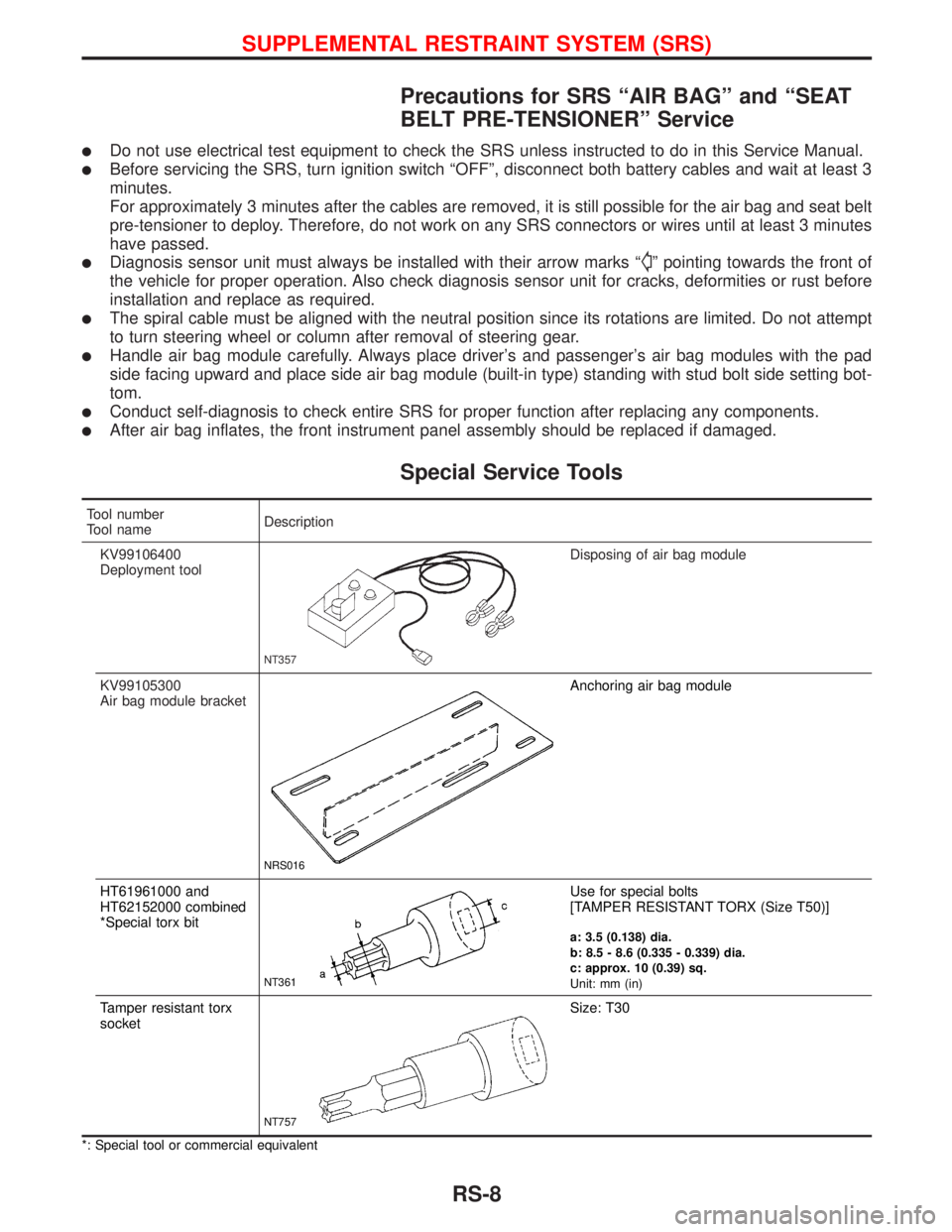
Precautions for SRS ªAIR BAGº and ªSEAT
BELT PRE-TENSIONERº Service
lDo not use electrical test equipment to check the SRS unless instructed to do in this Service Manual.
lBefore servicing the SRS, turn ignition switch ªOFFº, disconnect both battery cables and wait at least 3
minutes.
For approximately 3 minutes after the cables are removed, it is still possible for the air bag and seat belt
pre-tensioner to deploy. Therefore, do not work on any SRS connectors or wires until at least 3 minutes
have passed.
lDiagnosis sensor unit must always be installed with their arrow marks ªSº pointing towards the front of
the vehicle for proper operation. Also check diagnosis sensor unit for cracks, deformities or rust before
installation and replace as required.
lThe spiral cable must be aligned with the neutral position since its rotations are limited. Do not attempt
to turn steering wheel or column after removal of steering gear.
lHandle air bag module carefully. Always place driver's and passenger's air bag modules with the pad
side facing upward and place side air bag module (built-in type) standing with stud bolt side setting bot-
tom.
lConduct self-diagnosis to check entire SRS for proper function after replacing any components.
lAfter air bag inflates, the front instrument panel assembly should be replaced if damaged.
Special Service Tools
Tool number
Tool nameDescription
KV99106400
Deployment tool
NT357
Disposing of air bag module
KV99105300
Air bag module bracket
NRS016
Anchoring air bag module
HT61961000 and
HT62152000 combined
*Special torx bit
NT361
Use for special bolts
[TAMPER RESISTANT TORX (Size T50)]
a: 3.5 (0.138) dia.
b: 8.5 - 8.6 (0.335 - 0.339) dia.
c: approx. 10 (0.39) sq.
Unit: mm (in)
Tamper resistant torx
socket
NT757
Size: T30
*: Special tool or commercial equivalent
SUPPLEMENTAL RESTRAINT SYSTEM (SRS)
RS-8
Page 2193 of 2267

Description
The air bag deploys if the diagnosis sensor unit activates while the ignition switch is in ªONº or ªSTARTº
position.
The collision modes for which supplemental restraint systems are activated are different among the SRS
systems. For example, the driver's air bag module and passenger's air bag module are activated in a fron-
tal collision but not in a side collision.
SRS configurations which are activated for some collision modes are as follows;
SRS configuration Frontal collision Left side collision Right side collision
Driver's air bag moduleqÐÐ
Passenger's air bag moduleqÐÐ
Seat belt pre-tensioner (Driver's side)qÐÐ
Seat belt pre-tensioner (Passenger's side)qÐÐ
Side air bag module (LH) ÐqÐ
Side air bag module (RH) Ð Ðq
SRS585 Seat belt pre-tensioner
(Driver's side)
Satellite sensor (LH)
(G sensor for side
air bag LH)Diagnosis sensor unit
lAuxiliary power source (condenser)
lDrive circuit
lCPU
lG sensor
(for driver's and passenger's air bags,
seat belt pre-tensioner)
lSafing sensor
(for driver's and passenger's air bags,
seat belt pre-tensioner)
lSafing sensor
(for side air bag) Side air bag module (LH)
(Built-in type)Side air bag module
(RH) (Built-in type) Satellite sensor (RH)
(G sensor for side air bag
RH) Driver's air bag
modulePassenger's air bag
module
Seat belt pre-tensioner
(passenger's side)
SUPPLEMENTAL RESTRAINT SYSTEM (SRS)
RS-10
Page 2194 of 2267
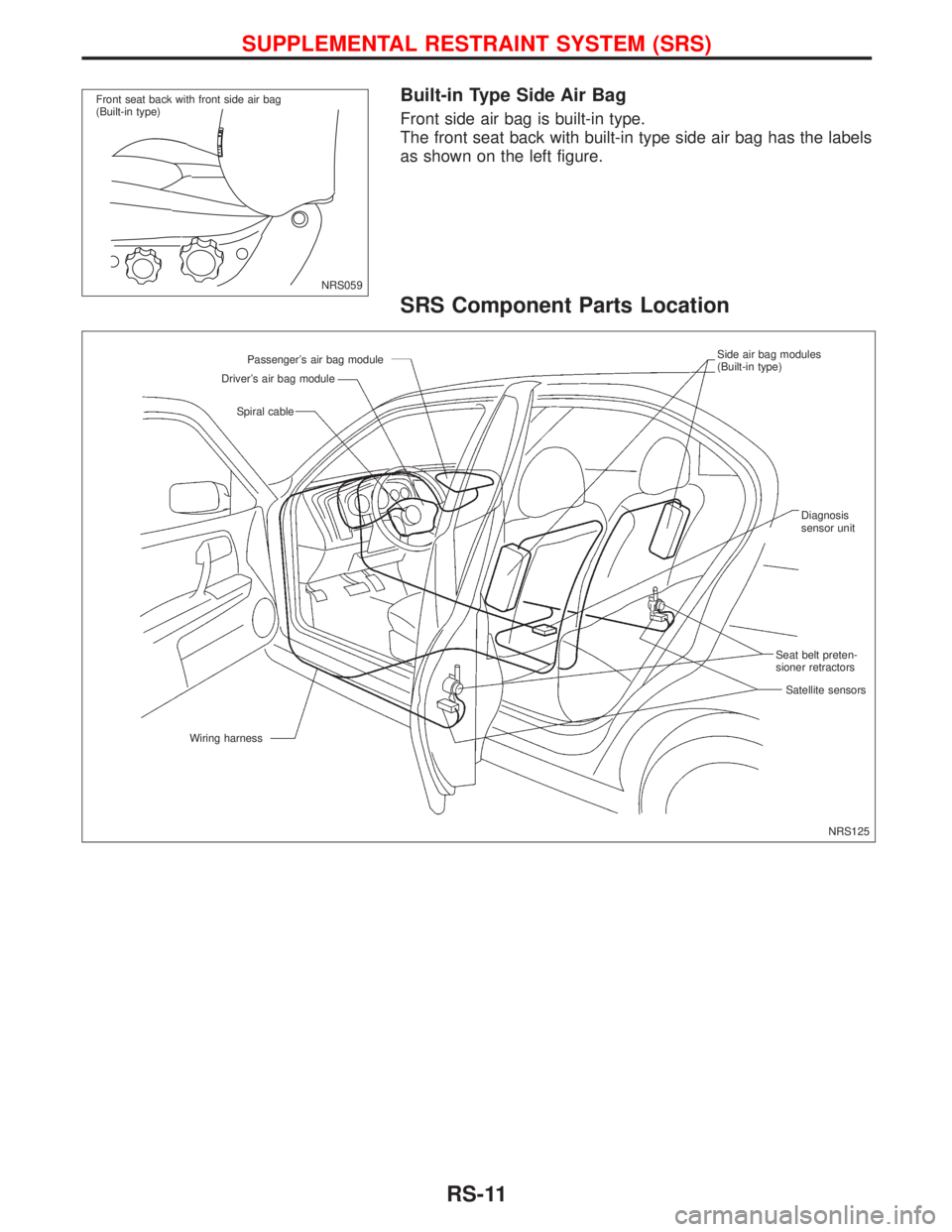
Built-in Type Side Air Bag
Front side air bag is built-in type.
The front seat back with built-in type side air bag has the labels
as shown on the left figure.
SRS Component Parts Location
NRS059
.Front seat back with front side air bag
(Built-in type)
NRS125 Passenger's air bag module
Driver's air bag module
Satellite sensors Spiral cable
Wiring harness
.Seat belt preten-
sioner retractors
.Diagnosis
sensor unit
.Side air bag modules
(Built-in type)
SUPPLEMENTAL RESTRAINT SYSTEM (SRS)
RS-11
Page 2195 of 2267
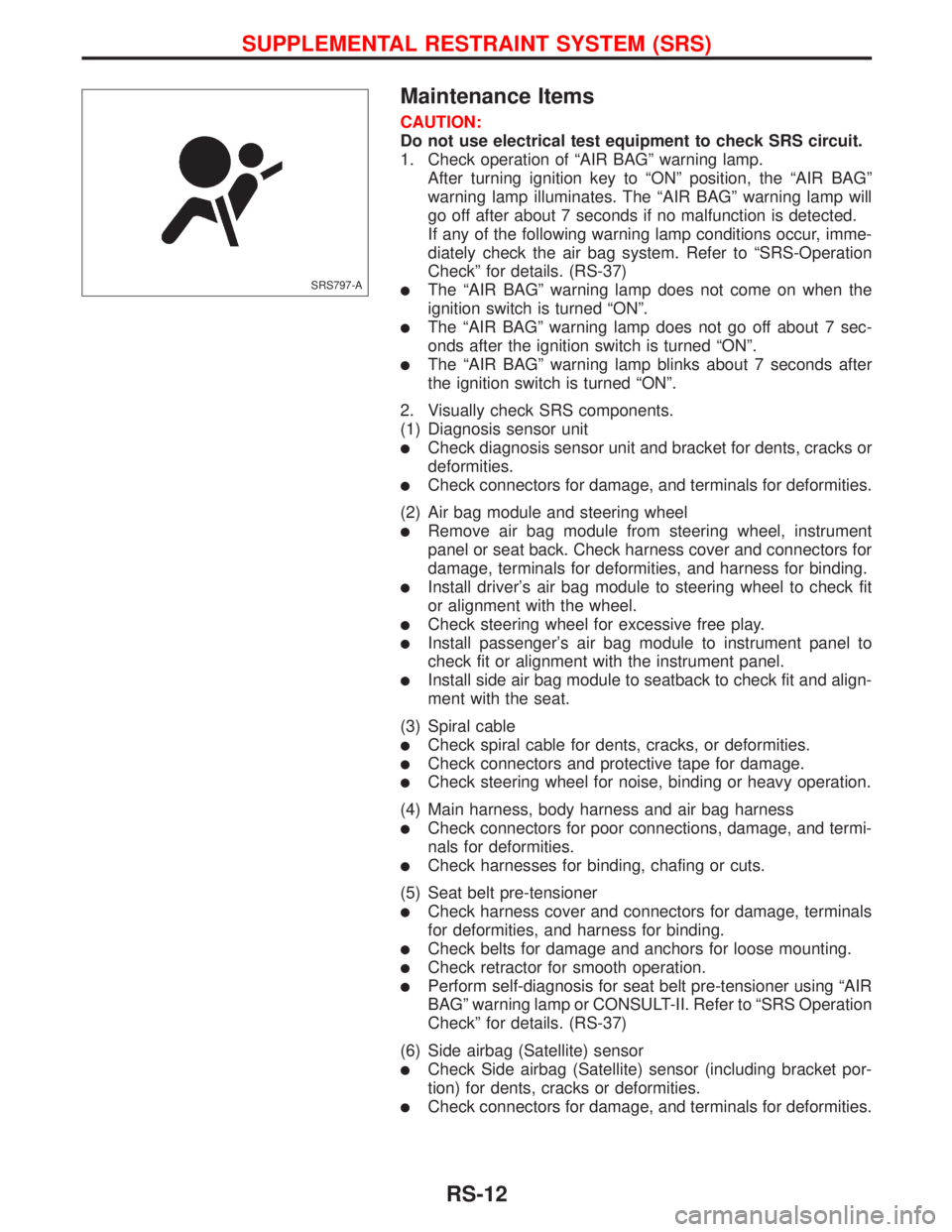
Maintenance Items
CAUTION:
Do not use electrical test equipment to check SRS circuit.
1. Check operation of ªAIR BAGº warning lamp.
After turning ignition key to ªONº position, the ªAIR BAGº
warning lamp illuminates. The ªAIR BAGº warning lamp will
go off after about 7 seconds if no malfunction is detected.
If any of the following warning lamp conditions occur, imme-
diately check the air bag system. Refer to ªSRS-Operation
Checkº for details. (RS-37)
lThe ªAIR BAGº warning lamp does not come on when the
ignition switch is turned ªONº.
lThe ªAIR BAGº warning lamp does not go off about 7 sec-
onds after the ignition switch is turned ªONº.
lThe ªAIR BAGº warning lamp blinks about 7 seconds after
the ignition switch is turned ªONº.
2. Visually check SRS components.
(1) Diagnosis sensor unit
lCheck diagnosis sensor unit and bracket for dents, cracks or
deformities.
lCheck connectors for damage, and terminals for deformities.
(2) Air bag module and steering wheel
lRemove air bag module from steering wheel, instrument
panel or seat back. Check harness cover and connectors for
damage, terminals for deformities, and harness for binding.
lInstall driver's air bag module to steering wheel to check fit
or alignment with the wheel.
lCheck steering wheel for excessive free play.
lInstall passenger's air bag module to instrument panel to
check fit or alignment with the instrument panel.
lInstall side air bag module to seatback to check fit and align-
ment with the seat.
(3) Spiral cable
lCheck spiral cable for dents, cracks, or deformities.
lCheck connectors and protective tape for damage.
lCheck steering wheel for noise, binding or heavy operation.
(4) Main harness, body harness and air bag harness
lCheck connectors for poor connections, damage, and termi-
nals for deformities.
lCheck harnesses for binding, chafing or cuts.
(5) Seat belt pre-tensioner
lCheck harness cover and connectors for damage, terminals
for deformities, and harness for binding.
lCheck belts for damage and anchors for loose mounting.
lCheck retractor for smooth operation.
lPerform self-diagnosis for seat belt pre-tensioner using ªAIR
BAGº warning lamp or CONSULT-II. Refer to ªSRS Operation
Checkº for details. (RS-37)
(6) Side airbag (Satellite) sensor
lCheck Side airbag (Satellite) sensor (including bracket por-
tion) for dents, cracks or deformities.
lCheck connectors for damage, and terminals for deformities.
SRS797-A
SUPPLEMENTAL RESTRAINT SYSTEM (SRS)
RS-12